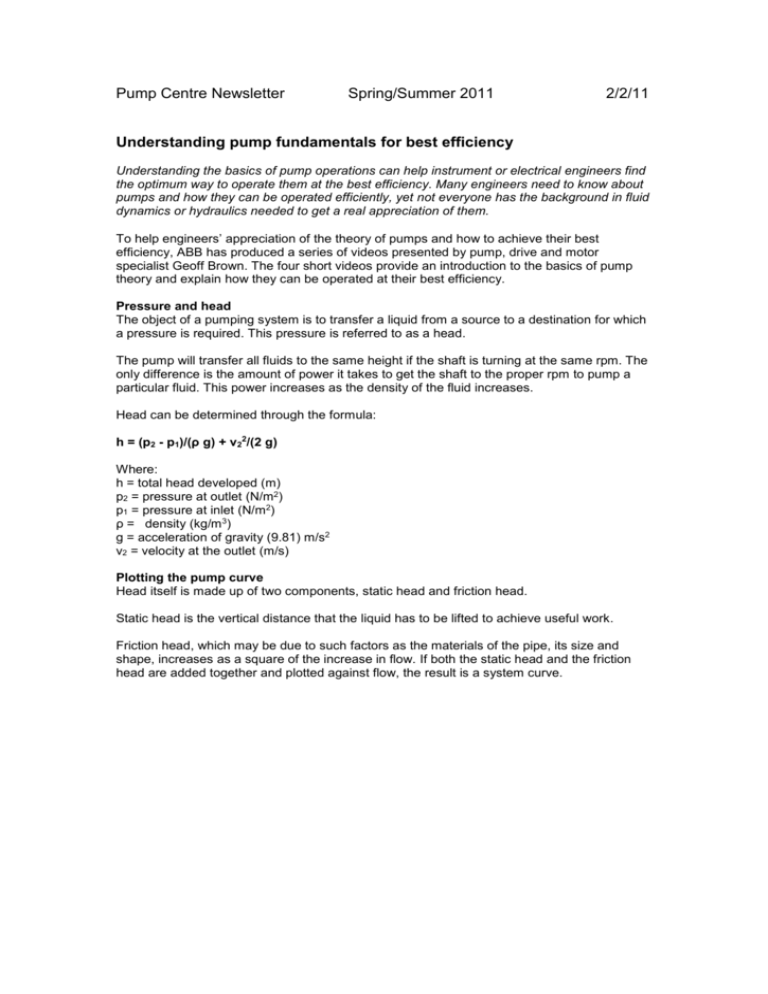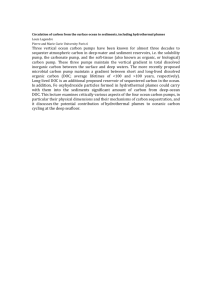Understanding pump fundamentals for best
advertisement

Pump Centre Newsletter Spring/Summer 2011 2/2/11 Understanding pump fundamentals for best efficiency Understanding the basics of pump operations can help instrument or electrical engineers find the optimum way to operate them at the best efficiency. Many engineers need to know about pumps and how they can be operated efficiently, yet not everyone has the background in fluid dynamics or hydraulics needed to get a real appreciation of them. To help engineers’ appreciation of the theory of pumps and how to achieve their best efficiency, ABB has produced a series of videos presented by pump, drive and motor specialist Geoff Brown. The four short videos provide an introduction to the basics of pump theory and explain how they can be operated at their best efficiency. Pressure and head The object of a pumping system is to transfer a liquid from a source to a destination for which a pressure is required. This pressure is referred to as a head. The pump will transfer all fluids to the same height if the shaft is turning at the same rpm. The only difference is the amount of power it takes to get the shaft to the proper rpm to pump a particular fluid. This power increases as the density of the fluid increases. Head can be determined through the formula: h = (p2 - p1)/(ρ g) + v22/(2 g) Where: h = total head developed (m) p2 = pressure at outlet (N/m2) p1 = pressure at inlet (N/m2) ρ = density (kg/m3) g = acceleration of gravity (9.81) m/s2 v2 = velocity at the outlet (m/s) Plotting the pump curve Head itself is made up of two components, static head and friction head. Static head is the vertical distance that the liquid has to be lifted to achieve useful work. Friction head, which may be due to such factors as the materials of the pipe, its size and shape, increases as a square of the increase in flow. If both the static head and the friction head are added together and plotted against flow, the result is a system curve. Figure 1 – System curve It is this system curve which needs to be investigated for possible energy savings. Where the static head is relatively high compared to the friction head, there is less possibility of savings. Finding the best operating point A typical centrifugal pump will have a number of curves that are published by the manufacturer. Figure 2 – Curve graphs The most important is the head volume curve, which starts at a point called the closed valve head where the pump is not actually doing any work just generating pressure. On this curve, as the flow rate increases the available head drops off. The power curve represents the effect of the head and flow and the efficiency. The other curve is the NPSH - the Net Positive Suction Head required. This is the immersion that the pump impeller needs to avoid it cavitating and becoming damaged. Another significant point is the best efficiency point, where the pump should be set to run to achieve the best overall solution for a particular system. Affinity laws plot efficiency The affinity laws state that for a specific pump, the volume of fluid pumped is proportional to speed. The head is proportional to the square of this speed, while the power absorbed is proportional to the cube of this speed. For any pump even a small change in speed can result in quite significant changes to these parameters and especially to the power. Variable speed control for optimum parallel pumping A typical configuration might have a duty pump, an assist pump and a standby pump. Two of these three pumps may be running at any one time. In this case it is possible to run pumps of different sizes in parallel as long as the closed valve heads of all the pumps are similar. Even nominally identical pumps won’t be absolutely identical because of manufacturing tolerances. Figure 3 shows three pumps set in parallel and the affect of the combined head-volume curves. Figure 3 – Head v flow rate for three pumps with system curve Adding a typical system curve it can be seen that the flow from two pumps is less than twice the flow of a single pump, equally the flow from three pumps in this case is less than the effect of three single pumps. The reason is that we are increasing the discharge pressure by going up the system curve. With parallel pumps the greatest energy savings can be achieved by running all three pumps on variable speed. So as the head is rising the work done by the pumps increases, meaning that optimum savings are achieved by having all the pumps variable speed controlled. Geoff Brown, Consultant Discrete Automation and Motion, ABB Limited Tel: 01925 741 111; Email: energy@gb.abb.com; Web: www.abb.co.uk/energy





